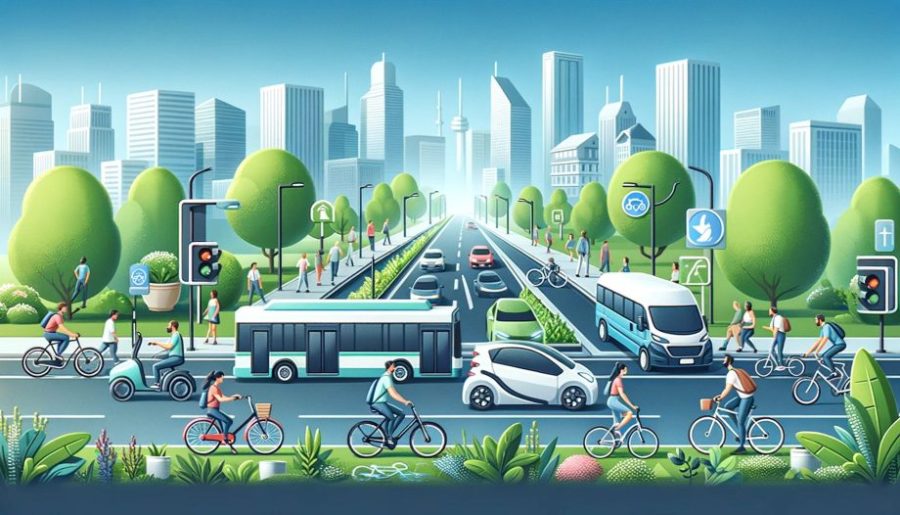
Dive into the benefits of sustainable transportation! Learn how greener mobility can enhance our planet, health, and communities in a friendly tone.
Sustainable Transportation Benefits
Key Takeaways:
- Benefits of sustainable transportation include:
- Reduced environmental pollution
- Decreased greenhouse gas emissions
- Improved public health
- Enhanced urban livability
- Economic savings.
- By choosing greener modes of transport, we contribute to a healthier planet and a more sustainable future for all.
Ever wondered about the benefits of sustainable transportation? It’s not just about reducing emissions.
This shift promises a healthier planet, economic savings, and a stronger community spirit!
Join us as we explore the greener side of getting around, making our world a better place one ride at a time.
The Urgent Shift to Sustainable Transportation
In the modern era, the drive toward sustainable transportation has escalated from a mere trend to an absolute necessity.
The threats posed by climate change and air pollution have never been more palpable, highlighting the urgent need for action.
Navigating Climate Change and Resource Depletion
Our planet’s battle against the adverse effects of climate change, coupled with the dwindling availability of non-renewable resources, underscores the critical importance of moving towards more sustainable transportation methods.
This pivotal shift is not just about safeguarding our environment but about securing a viable future for subsequent generations.
A Multitude of Benefits
Adopting sustainable transportation is far more than an environmental imperative.
It heralds a host of advantages that span economic growth, enhanced public health, and improved societal outcomes.
By integrating electric vehicles, cycling, walking, and efficient public transit into our daily lives, we stand to significantly reduce our carbon footprint, ease our dependence on fossil fuels, and foster a healthier, more equitable society.
Forging a Sustainable Legacy
The transition towards greener modes of transport represents a crucial step in our journey towards environmental stewardship and social equity.
It’s about making informed choices that not only benefit our planet in the immediate term but also lay down the foundations for a sustainable legacy that will benefit future generations.
Environmental Benefits of Sustainable Transportation

Sustainable transportation stands at the forefront of efforts to address the environmental challenges posed by traditional transportation systems.
Environmental Benefits
This strategic shift towards greener modes of transport is crucial for significantly reducing carbon emissions, conserving our precious natural resources, and enhancing air quality. Below, we delve deeper into these benefits:
Reduction in Carbon Emissions and Air Pollution
Transitioning to electric vehicles (EVs) and other low-emission modes of transport is a game-changer in the fight against climate change.
Electric vehicles, in particular, represent a clean alternative to fossil fuel-powered cars, emitting far fewer greenhouse gases and pollutants into the atmosphere.
This shift can dramatically reduce the transportation sector’s carbon footprint, which is responsible for a significant portion of global emissions.
Sustainable transportation not only addresses the issue of carbon emissions but also significantly curtails air pollutants like nitrogen oxides and particulate matter, which have been linked to a range of respiratory and cardiovascular diseases.
Conservation of Natural Resources
The move towards sustainable transportation is synonymous with the efficient use of resources.
By reducing the reliance on fossil fuels, such as petroleum, and promoting the adoption of renewable energy sources for powering electric vehicles, we can conserve non-renewable resources and reduce the negative impacts of resource extraction and consumption.
Sustainable transportation encourages the development and use of alternative fuels like biodiesel, ethanol, and hydrogen, which can be produced from renewable resources, thereby fostering a more sustainable and resilient energy landscape.
Improvement in Air Quality and Public Health
Environmental Benefits
The transition to electric cars and electric bikes plays a pivotal role in slashing carbon dioxide emissions, substantially reducing global greenhouse gas emissions.
This shift is crucial, as highlighted by the World Health Organization, linking improved air quality directly to better public health outcomes.
By minimizing reliance on fossil fuels and cutting down on emissions from diesel vehicles and road vehicles, we contribute significantly to combating global warming and fostering healthier communities.
The benefits of sustainable transportation extend beyond the environment to directly impact public health.
Lower emissions result in cleaner air, which can significantly reduce the health risks associated with air pollution.
Studies have shown that pollutants from vehicle exhausts are linked to lung and heart conditions, asthma, and other respiratory illnesses.
By adopting cleaner modes of transportation, communities can experience a notable improvement in air quality, leading to healthier lives for their inhabitants.
Furthermore, promoting active forms of transportation such as walking and cycling can contribute to improved physical health, reducing obesity rates and associated health conditions.
In summary, the environmental benefits of sustainable transportation are profound and multifaceted, addressing urgent global issues such as climate change, resource depletion, and public health crises.
By making a concerted effort to adopt and promote sustainable transportation options, societies can make significant strides toward a healthier, more sustainable future.
Economic Benefits of Sustainable Transportation

The shift towards sustainable transportation systems brings with it not just a cleaner environment but also significant economic advantages.
These benefits are wide-ranging, affecting individuals, communities, and the broader economy.
Let’s explore how making transportation more sustainable can lead to financial savings and stimulate economic growth.
Cost Savings for Individuals and Public Budgets
Embracing fuel-efficient vehicles, including hybrid vehicles and electric buses, offers substantial savings on fuel costs.
The transport sector in the United States is at the forefront of this shift, with innovations that not only lower maintenance costs for individuals and local businesses but also promote energy efficiency.
The financial benefits are evident, with data from the U.S. Department of Energy and the World Bank highlighting the significant total incremental investment in sustainable public transportation systems, demonstrating the economic advantage of adopting green transportation practices.
- Reduced Fuel and Maintenance Expenses: By opting for more efficient transportation modes, such as electric vehicles, individuals and public entities can enjoy lower costs related to fuel consumption and vehicle upkeep. This efficiency translates into direct savings, easing financial burdens on households and contributing to more sustainable municipal budgeting.
Job Creation and Economic Growth
- Boost in Employment Opportunities: The push for sustainable transportation infrastructure and green technologies opens up new avenues for job creation. From manufacturing electric vehicles to building and maintaining public transit systems, these sectors offer diverse employment opportunities.
- Stimulating Innovation and Development: Investments in sustainable transportation not only create jobs but also foster innovation in green technology. This innovation drives further economic development, positioning communities at the forefront of the clean energy transition.
Table: U.S. Department of Energy’s (DOE) Investment in Green Transport
Here’s a table summarizing the U.S. Department of Energy’s (DOE) investment in sustainable transportation, highlighting key areas of focus and the allocated funds, based on the information gathered:
| Area of Focus | Investment Amount | Description |
|---|---|---|
| Vehicle Technologies Office (VTO) | $133 million | Focuses on advanced batteries and electrification, engine and fuel technologies, lightweight materials, new mobility technologies, and alternative fuels demonstrations. |
| Fuel Cells Technologies Office (FCTO) | $64 million | Supports the H2@Scale initiative for expanding hydrogen production, storage, transport, and use, including heavy-duty trucks and other applications. |
| Bioenergy Technologies Office (BETO) | $100 million | Aims to reduce the price of biofuels, lower the cost of biopower, and enable high-value products from biomass or waste resources. |
These investments showcase the DOE’s comprehensive approach to supporting sustainable transportation through research and development across a variety of technologies and fuels.
The focus spans from enhancing electric vehicle (EV) technology and infrastructure to promoting bioenergy and hydrogen as alternative fuels, demonstrating a significant push towards reducing carbon emissions, improving energy efficiency, and fostering economic growth within the green energy sector.
These economic benefits underscore the value of investing in sustainable transportation, highlighting its role not only in environmental preservation but also in promoting financial stability and growth.
Social and Health Benefits of Sustainable Transportation

The advantages of sustainable transportation extend far beyond environmental conservation and economic growth, deeply impacting the social fabric and health of communities.
By promoting active and accessible modes of transportation, we can foster a healthier, more inclusive society.
Promotion of Physical Health through Active Transport
Encouraging active forms of transportation, such as bicycle riding and walking, provides excellent opportunities for physical exercise, directly benefiting people’s health.
The positive impact of reducing single-occupancy private vehicles through a modal shift to sustainable alternatives is clear.
Hybrid vehicles, electric bikes, and the increased use of public transportation systems contribute to a more active, healthier lifestyle for community members, underlining the vital connection between sustainable transportation practices and public health.
- Boosting Physical Activity: Encouraging walking and cycling as daily modes of transport can significantly increase individuals’ physical activity levels. This active engagement not only enhances overall health but also reduces the risk of chronic diseases associated with a sedentary lifestyle.
Enhanced Accessibility and Mobility
- Greater Access for All: Sustainable transportation systems, like enhanced public transit networks, are crucial in improving access to jobs, healthcare, education, and other essential services. This is particularly beneficial for marginalized populations, who may otherwise face barriers to mobility.
- Fostering Social Inclusion: By improving accessibility, sustainable transportation helps to bridge the gap between different societal groups, fostering a sense of inclusion and community connectivity.
These social and health benefits highlight the importance of sustainable transportation in building healthier, more equitable communities.
Through active transport and improved accessibility, we can promote well-being and social cohesion, making our cities more livable for everyone.
Improvement in Urban Living
Sustainable transportation is integral to creating more livable, accessible, and equitable urban environments.
By reducing traffic congestion and noise pollution, cities can become more enjoyable places to live.
Reduction in Traffic Congestion
- Sustainable Mobility Solutions: The adoption of public transit systems and bike-sharing programs plays a crucial role in easing the pressure on city roads. By providing efficient and reliable alternatives to private car use, these sustainable mobility options can significantly decrease traffic volume, leading to smoother commutes and less congested urban environments.
Creation of More Livable Spaces
Sustainable transportation practices are key to creating greener, more accessible urban areas.
By investing in green spaces and supporting the proliferation of local businesses, cities become more livable and vibrant.
Sustainable transit options, including mass transit and electric vehicle fleets, improve travel time and accessibility, making urban centers not just places to live, but places where communities thrive.
The adoption of electric buses and the promotion of sustainable public transportation underscore a holistic approach to urban planning, where energy efficiency and reduced environmental impact go hand in hand with enhanced urban living.
- Green Urban Areas: Investing in sustainable transportation infrastructure does more than just reduce congestion; it also leads to the creation of quieter, greener urban spaces. Initiatives such as expanding public parks, developing greenways for cyclists and pedestrians, and integrating green roofs and walls in urban design contribute to a reduction in noise pollution and an increase in public spaces for community engagement and recreation.
These strategic improvements in urban planning and transportation not only enhance the day-to-day experiences of city dwellers but also promote a more sustainable and inclusive urban future.
By prioritizing the development of accessible and efficient transportation options, cities can foster environments where residents enjoy a higher quality of life, with the added benefits of improved air quality and reduced environmental impact.
Through these efforts, sustainable transportation becomes a key driver in making our urban areas not only more livable but also more resilient in the face of ongoing environmental and social challenges.
FAQs on Sustainable Transportation
Navigating the landscape of sustainable transportation brings up many questions about its impact, necessity, and benefits.
From understanding the profound effects on the environment and economy to grasping the social and health advantages, our FAQs delve into the essential queries surrounding sustainable transport, providing insights for a clearer, greener future.
Q: What is the impact of a sustainable transport system?
A: Sustainable transport systems significantly reduce environmental pollution, conserve resources, and enhance public health by lowering greenhouse gas emissions and reducing reliance on fossil fuels.
Q: Why does transport need to be sustainable?
A: Transport must be sustainable to tackle climate change, reduce urban congestion, minimize air pollution, and conserve non-renewable energy resources, fostering healthier and more resilient cities.
Q: What is the goal of sustainable transportation?
A: The goal is to provide efficient, accessible, and low-impact transport options that reduce environmental damage, promote social well-being, and support economic growth by favoring more sustainable modes like walking, cycling, and public transit.
Q: How does sustainable transport save money?
A: It saves money by decreasing the costs related to fuel and vehicle maintenance, reducing healthcare expenses from pollution-related illnesses, and lessening the need for costly road infrastructure maintenance.
Q: Who benefits the most from sustainable transportation?
A: Everyone benefits, especially urban dwellers who enjoy better air quality and reduced congestion, marginalized communities with improved access to services, and future generations who will inherit a healthier planet.
Q: What are the cons of sustainable transportation?
A: Challenges include the initial costs of developing new infrastructure, the need for advancements in technology, and overcoming resistance to changing conventional transport habits.
Q: How does transportation improve the economy?
A: Transportation boosts the economy by facilitating trade, improving access to jobs and markets, stimulating infrastructure investment, and promoting tourism, thereby driving economic growth and job creation.
Q: What is the best sustainable transportation?
A: The best option varies by context but generally includes walking, cycling, public transit, and electric vehicles due to their low environmental impact and health and cost benefits. The optimal choice often involves a mix of these modes to accommodate different needs and urban designs.
Conclusion: The Future of Sustainable Transportation
The journey towards sustainable transportation is not just a path to reducing our environmental footprint—it’s a gateway to a future where our planet, economies, and societies thrive together.
By exploring the numerous benefits of sustainable transport, we’ve seen how significant the impact of our individual choices can be. Let’s delve into the key takeaways from our exploration.
Key Takeaway:
- The holistic approach to embracing sustainable transportation is a cornerstone in our fight against global warming.
- As a major contributor to reducing metric tons of carbon dioxide, sustainable transportation solutions like electric cars, fuel-efficient vehicles, and sustainable transit options are imperative.
- They represent not just a shift in how we move, but a transformative step towards a more sustainable, equitable, and healthy future for our planet and its inhabitants.
- By making informed choices about our mode of transport, we’re not only contributing to the well-being of our environment but also paving the way for economic growth, social inclusion, and improved public health.
The Power of Individual Choices
Every decision to walk, cycle, use public transit, or drive an electric vehicle contributes to a larger wave of change.
These choices not only reduce carbon emissions and pollution but also set a precedent for sustainable living that can inspire others to follow suit.
Collective Impact on Our Planet
The collective adoption of eco-friendly transportation methods has a profound effect on the health of our planet.
By minimizing the reliance on fossil fuels and decreasing greenhouse gas emissions, we’re taking crucial steps towards mitigating the effects of climate change and preserving the environment for future generations.
Strengthening Economies and Communities
Sustainable transportation isn’t just good for the Earth—it’s beneficial for our economies and societies.
From creating jobs in green technologies to making our cities more livable and accessible, the move towards greener mobility supports economic growth and builds stronger, more connected communities.
A Path Towards Healthier Lives
Lastly, the shift to sustainable transportation methods offers immense health benefits, from reducing air pollution that can lead to respiratory and cardiovascular diseases to promoting physical activity through active transport options like biking and walking.
Final Thoughts
In conclusion, the move towards sustainable transportation is a critical step in our journey towards a more sustainable, equitable, and healthy world.
As individuals, our choices have power—the power to drive change, inspire action, and create a legacy of sustainability for generations to come.
By embracing greener mobility, we’re not just making a choice for today; we’re paving the way for a brighter, more sustainable future for all.






